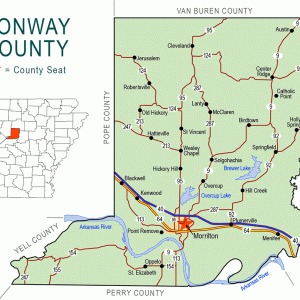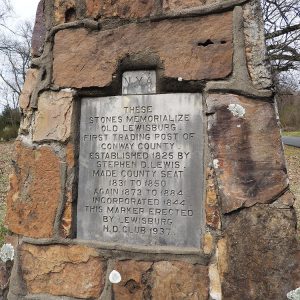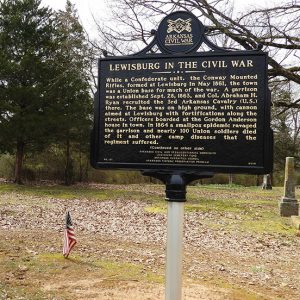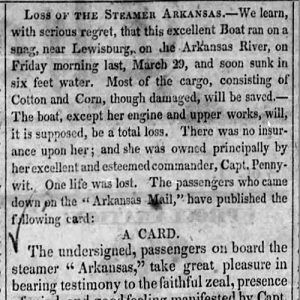calsfoundation@cals.org
Lewisburg (Conway County)
Lewisburg is a former town in Conway County. It was a vibrant community from 1831 until 1883, when it ceased being the county seat of Conway County, replaced by Morrilton. An important town on the Arkansas River, Lewisburg played a significant role in the Civil War. But following the war, the town was bypassed by the railroad, which favored the development of Morrilton.
Lewisburg was founded as a trading post and steamboat landing along the Arkansas River in 1825 by Stephen D. Lewis—hence the name Lewisburg. (Some later sources also credit Lewis’s father, General William Lewis, although he died in January 1825.) The town was an important stagecoach stop and played a part in the Indian Removal along the Trail of Tears.
Lewisburg was located about one mile southeast of what would become Morrilton. Incorporation as a town occurred in 1844 with a sizable population and numerous businesses. Strategically located on the Arkansas River, Lewisburg gained the reputation as being one of the best transportation routes for people and products of the day. (However, the steamboat Cherokee did experience a boiler explosion at Lewisburg on December 11, 1840.) By the mid-nineteenth century, Lewisburg claimed over eighty businesses, including two sawmills, two gristmills, a flour mill, a cotton gin, hotels, saloons, several stores, and even an opera house. Lewisburg became the county seat in 1831, lost that title to Springfield (Conway County) in 1850, and then regained it in 1873.
A Mr. McNabb established the first ferry at Lewisburg about 1848. The ferry passed through several hands until W. P. Wells and John Ward took possession in 1866. The Lewisburg ferry was used until 1920, when the bridge across the Arkansas River was built.
The Little Rock and Fort Smith Railroad began surveying for a route through Lewisburg in 1850, but the Civil War intervened. Following the war, the railroad asked Lewisburg citizens for a monetary contribution to aid in the construction of the railroad. This never happened because Lewisburg had been hard hit by the war and money was scarce in the town.
Lewisburg was a significant river port town, located about fifty miles west of Little Rock (Pulaski County) on the way to Fort Smith (Sebastian County) and Indian Territory, which made it vulnerable to attack by the Union army. The town fell to the Union on September 28, 1863, and was occupied until August 1865. A Union refugee camp was established in the town under very harsh conditions involving food shortages, disease (including smallpox), and poor sanitation. Many men, women, and children died there. Too, there was significant local division between those who favored the South and others who favored the North.
The occupation army was led by Colonel Abraham H. Ryan, who commanded the newly formed Third Arkansas Regimental Cavalry. Confronting Colonel Ryan was a guerrilla assortment of soldiers led by Colonel Allen R. Witt and his Quitman Rifles, a division of the Tenth Arkansas Cavalry. Colonel Ryan was in association with Williams’s Raiders commanded by T. Jeff Williams. Both Williams and Witt were local, and thus the rivalry was intense and personal. A showdown took place on February 12, 1865, on the road from Lewisburg to Dover (Pope County) and became known as the Skirmish of Lewisburg. Colonel Ryan and his troops prevailed, but Witt and about thirty members of his guerrilla force escaped and rode north to the Center Ridge (Conway County) community to the residence of Captain Williams, called him out, and shot him as he stood in his front doorway. The Williams family retaliated by killing more than half of Witt’s band.
A Freedmen’s Bureau office opened in June 1866 to aid freed people with labor contracts and to run a school. A Male and Female Academy opened in Lewisburg in 1867. However, as elsewhere in the state and in the South in general, law and order continued to break down, with outlawry, thievery, and killings carrying over into the days of Reconstruction. In 1868, the town became embroiled in conflict between the Ku Klux Klan and the Republican militia during voter registration. Parts of Lewisburg were burned twice during December, and Governor Powell Clayton declared martial law in Conway County on December 8, 1868. The militia that patrolled the county was composed of one company of freedmen and three white companies. Governor Clayton replaced the militia with federal soldiers until martial law was ended in 1869.
A notorious act of lawlessness in Lewisburg following the war was Frank M. Hill’s murder of prominent Lewisburg physician S. W. Crittenden in June 1874. The motive was never ascertained, but robbery was suspected. Fugitive Hill hid out with his brother-in-law George Looney at the Smith Williams house near Lewisburg. Deputy Sheriff Dickerson took a small posse to surround the Williams residence, hoping to flush out Hill. In the shootout that followed, a member of the posse, John Absalom Rorie, was killed; a fellow posse member and friend to Dr. Crittenden, Louis McClure, was wounded but survived; and fugitive Hill was wounded in his hip but lived to stand trial.
Many of the town leaders believed erroneously that the railroad had no choice but to go through Lewisburg because of its strategic location. The Little Rock and Fort Smith Railroad was, however, given a choice when two leading businessmen, Edward Henry Morrill and James Miles Moose, donated land about a mile north of the river town; thus the tracks bypassed Lewisburg, and Morrill’s Town was begun, incorporated in 1879 with a population of about 800. It is said that the first station agent, Captain J. W. Boot, flipped a coin and Morrilltown (original spelling for Morrilton) won out over Moosetown. In 1883, Morrilton was designated the new county seat and remains as such in the twenty-first century.
In 1880, Lewisburg still had a population of 356 and several businesses. But more families began to move out as the nearby town of Morrilton developed with the stimulus of the railroad. By 1930, not much was left of the historic community on the bluffs overlooking the Arkansas River. It is today a part of Morrilton, with a few old cisterns and two cemeteries the only remnants of a once thriving riverboat town in north-central Arkansas.
For additional information:
Barnes, Kenneth C. “The Williams Clan: Mountain Farmers and Union Fighters in North Central Arkansas.” Arkansas Historical Quarterly 52 (Autumn 1993): 286–317.
The Biographical and Historical Memoirs of Western Arkansas: Yell, Pope, Johnson, Logan, Scott, Polk, Montgomery, and Conway Counties. Easley, SC: Southern Historical Press, 1978.
Conway County Historical Society. Conway County: Our Land, Our Home, Our People. Little Rock: Historical Publication of Arkansas, 1992.
Finley, Randy. From Slavery to Uncertain Freedom: The Freedmen’s Bureau in Arkansas, 1865–1869. Fayetteville: University of Arkansas Press, 1996.
Historical Reminiscences and Biographical Memoirs of Conway County, Arkansas. Chicago: Goodspeed Publishing Co., 1890.
Shinn, Josiah H. Pioneers and Makers of Arkansas. Baltimore: Genealogical Pub. Co., 1967.
Trelease, Allen. White Terror: The Ku Klux Klan Conspiracy and Southern Reconstruction. New York: Harper, 1971.
Kenneth Rorie
Van Buren, Arkansas









Comments
No comments on this entry yet.